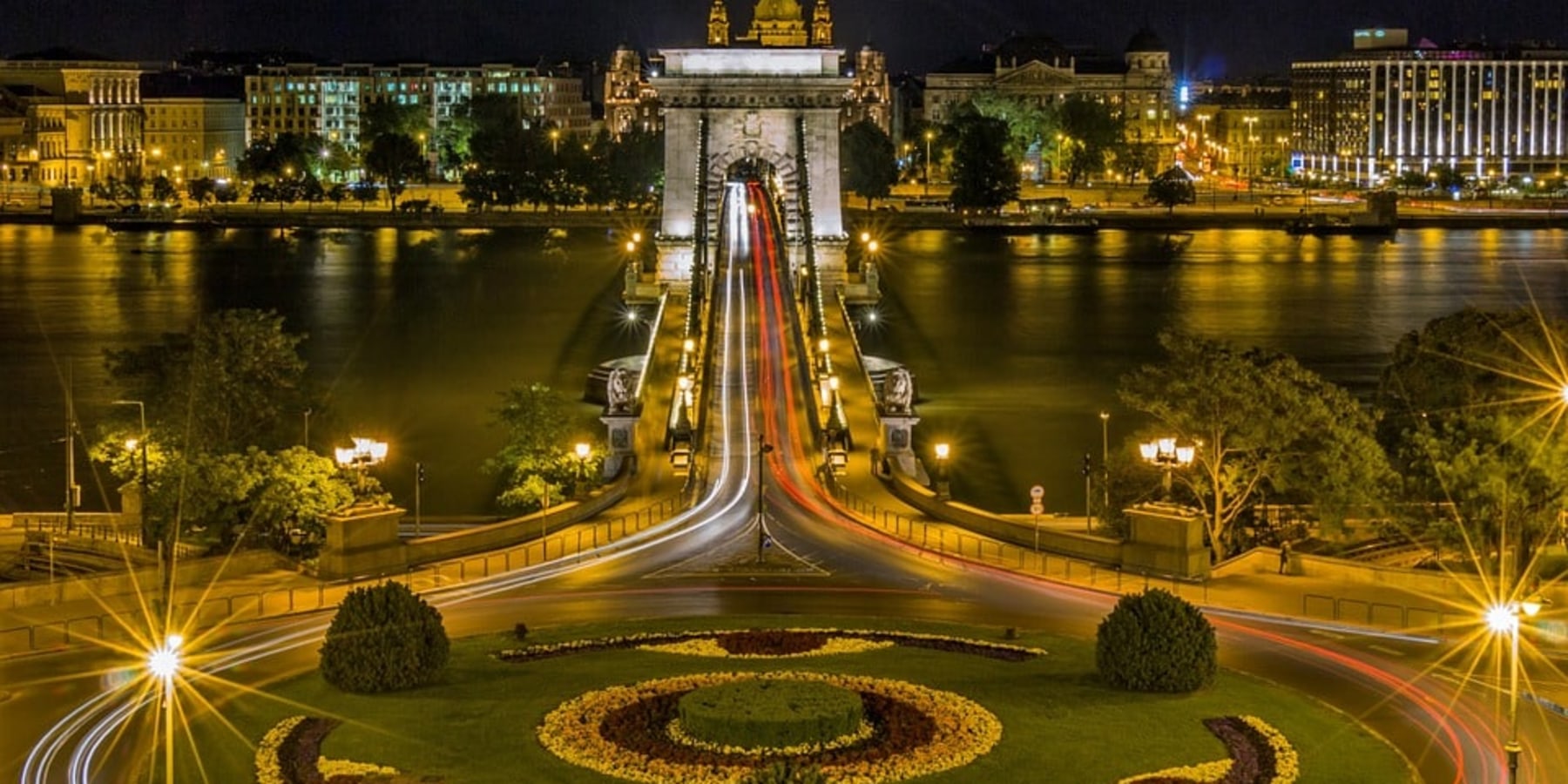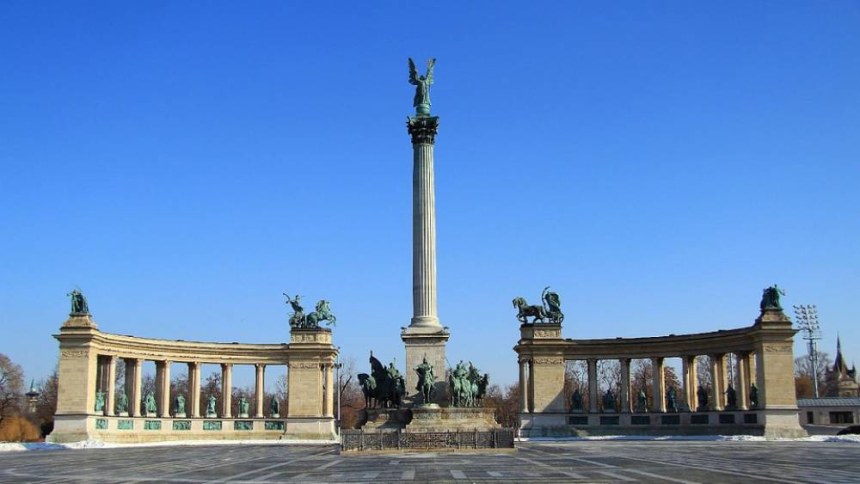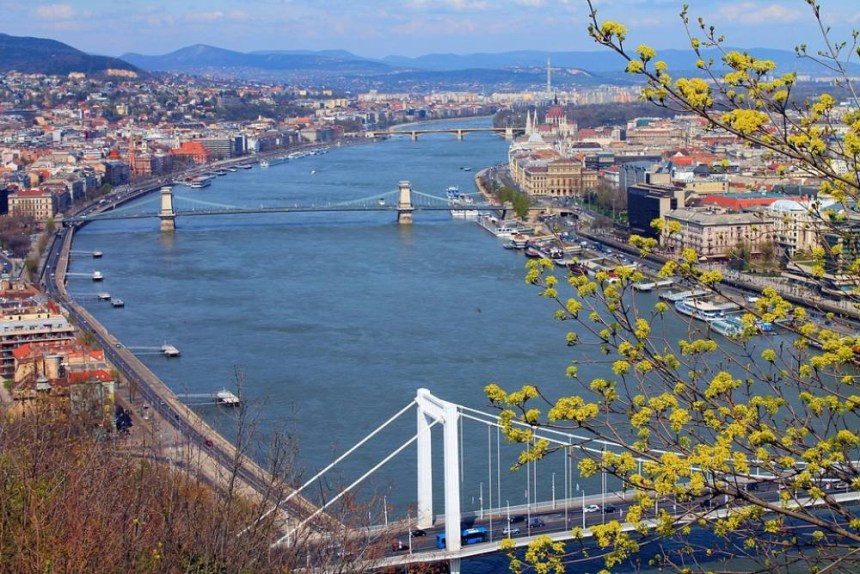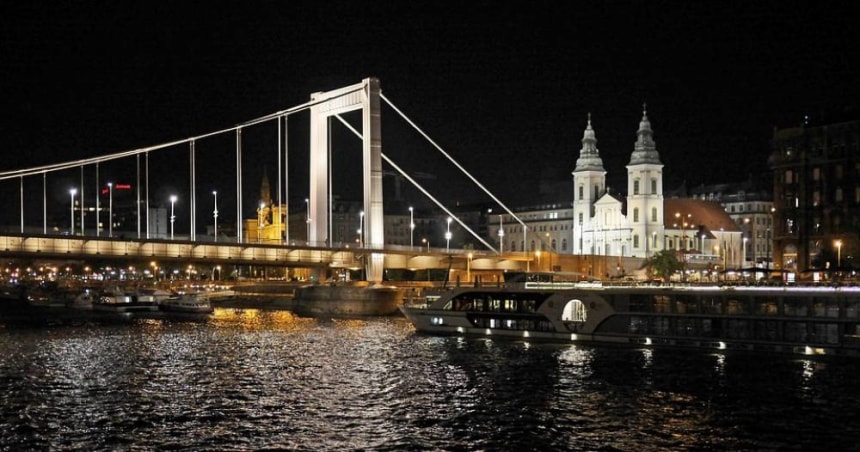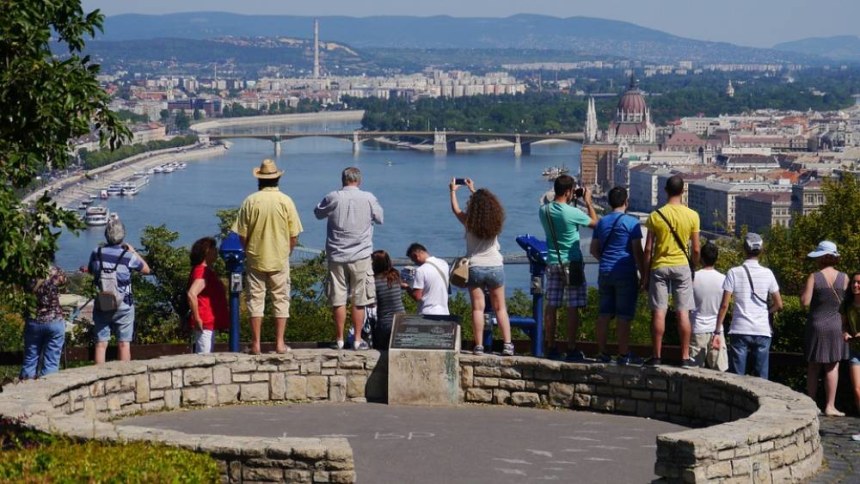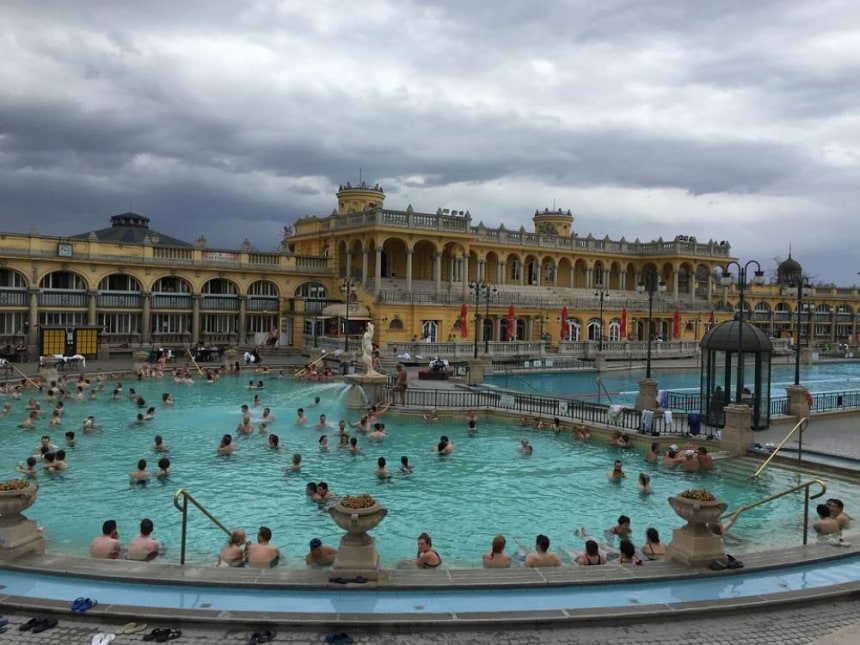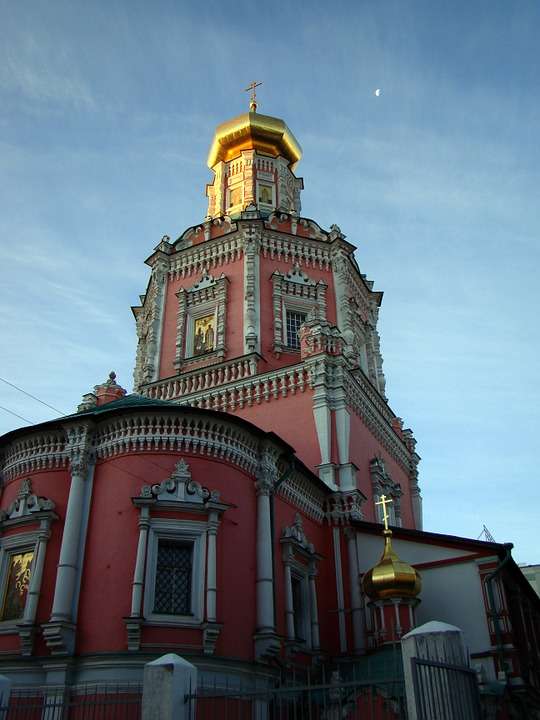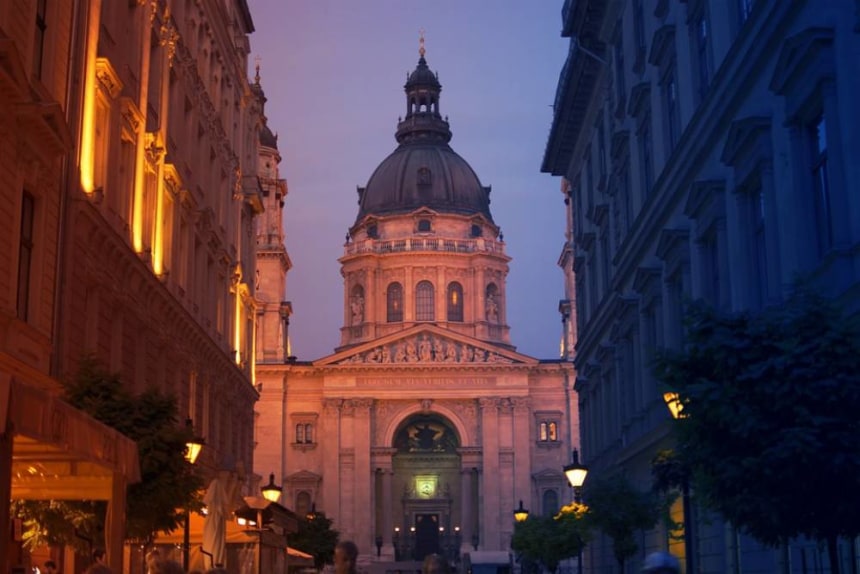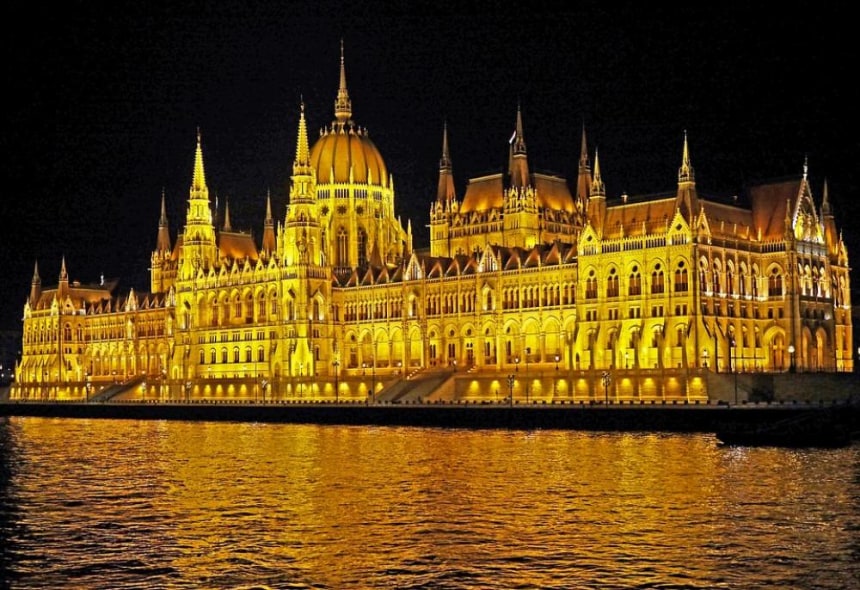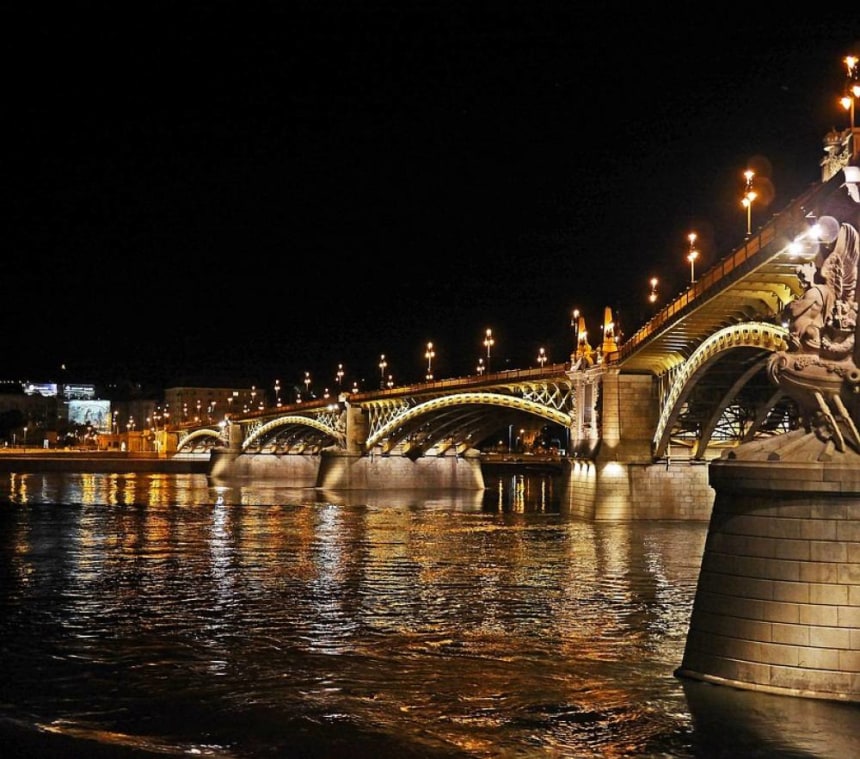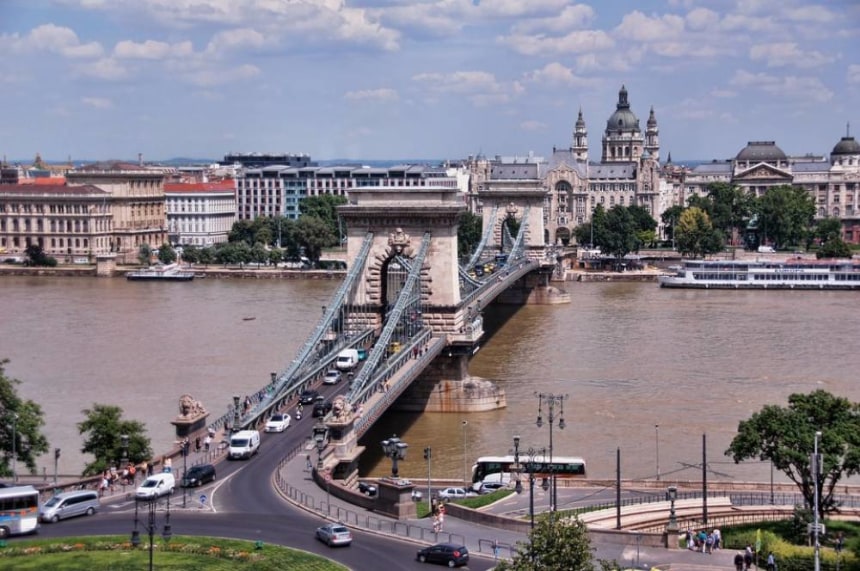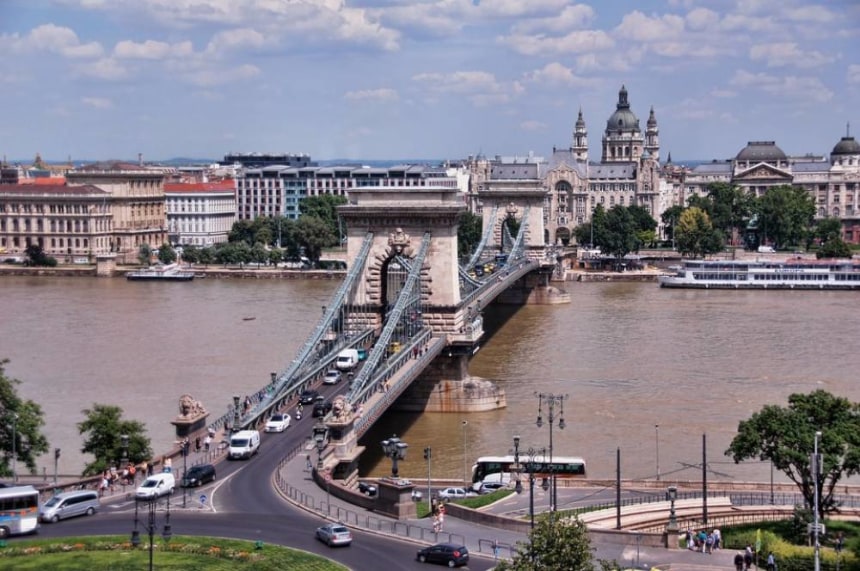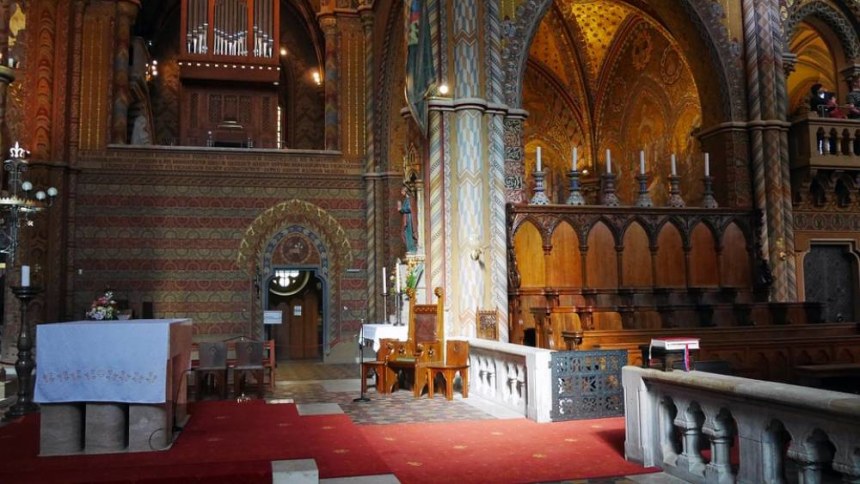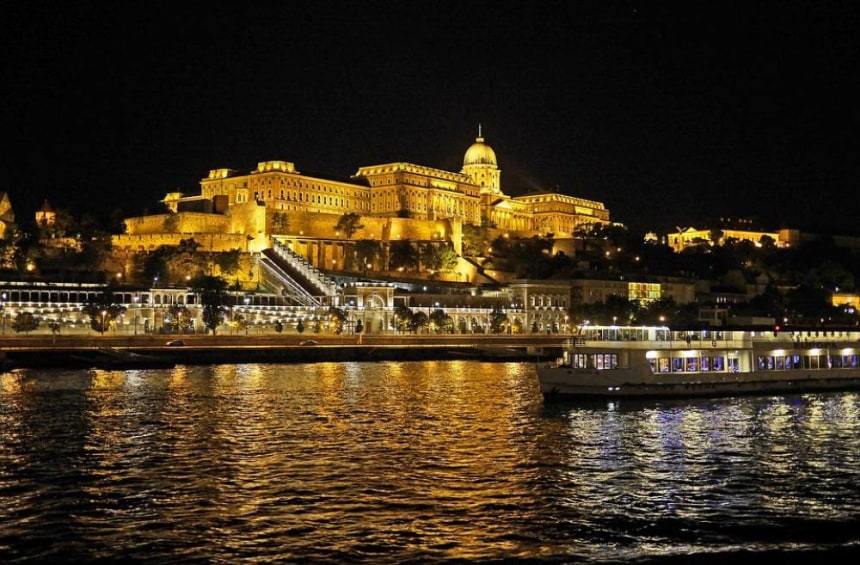
Hello and welcome to Budapest. I will be your local guide for the city walking tour that takes about 3-4 hours.
1. The weather looks nice for today. During the tour we will see Heroes’ Square, Saint Gellért Hill, and the Castle District. Take pictures, walk around, take some refreshments.
Once we had 3 cities (Buda, Oldbuda, Pest).They were combined to become one city in 1873. It consist of 2 parts, Buda and Pest. We have 2 Islands: Margaret and the Csepel Islands. We have about 2 million ihabitans and 2000 years of history. The Celts settled down here first, they were defeated by the Romans in 10 A.D and they were turned into a Roman provincial capital called AQUINCUM. The vrovince’s name was PANNONIA.
2. The border was at the river DANUBE. The Romans built military watch-towers to control those barbarian tribes on the other side of the Danube.
Later on various people lived here, such as the HUNS, AVARS, and the SLAVES during the great migration in the 5th century. Our ancestors arrived to the CARPATIAN BASIN and accuped it in 896. Our language belongs to the FINNO-UGRIAN language family. Durin the the conquest period they lived together with the SLAVE TRIBES.
3. Budapest is situated on the banks of the RIVER DANUBE and its territory 202 square miles ( 525 km2 ). Buda is hilly and Pest is completely flat. Pest is twice biger. The population of the city is about 2.5 millions, the country’s population is about 10.5 millions. In the 13th century BUDA became the royal settlement. They were only united in 1873 under the name BUDAPEST. The origin of the word BUDA is from the SLAVES, they called it VODA ÍZ…BUDA.
4. The oldest church is the PARIS CHURCH in Pest, built in the 13th century upon the ruins of Roman military watch-tower. Now it’s in Baroque style, its backside in Gothic style. On the left you can see the FACULTY OF HUMANITIES EÖTVÖS LORAND UNIVERSITY. To the right is the ELISABETH BRIDGE. We have 8 bridges. All were blown up in the World War II. ELISABETH is a newly designed bridge by PÁL SAVOLY in 1964. We have 6 for normal traffic use and 2 for the railway.
5. On the other side is the GELLÉRT HILL with the staue of SAINT GELLÉRT. On the top of the hill we can see the MONUMENT OF LIBERTY and the CITADEL. We can enjoy a beautiful view from there. We can see the INTERNATIONAL ÖTŐ on our right. You can travel by HYDROFOIL from VIENNA to BUDAPEST twice a day. Ahead of us we we can see the LIBERTY-BRIDGE and the nearest building is the UNIVERSITY OF ECONOMICS it was turned into a university from a previous CUSTOM’S HOUSE. Next to this you can see the MARKET ámháztéri Csarnok. The City Walls were demolished=lerombolva 200 years ago. This was the "Little Boulevad”= kiskörut.
6. Tha Calvin Square was built originally outside of the city walls because of its Protestant Church. So, not far from here we can see the National Museum, built by Pollack Mihály in 1839-1846. There is an archeological collection, and an exhibition of the Hungarian’s History as well. After long negotiations we got back the Royal Crown and Crown Jewels from the United States in 1978. It is now in the main hall of the museum. Now we can see the Faculty of Natural Sciences of Eötvös Loránd University. On the corner you can see the oldest Hotel of the downtown, called ASTORIA. The most famous restaurant, the Mátyás Cellar, named after the famous king with excellent food and gipsy music.
7. On aur left the Vaci street begins. This is the main pedestrian area. The Majority of the private shops are here. The Franciscan Church is an elegant Catholic Church, built in Baroque style in the 18th century. There is a relief on its wall, it shows a scene from the Great Flood (We can see Baron Wesselényi, who rescued a lot of people. The Danube floods in our time as well. We are driving along the Kossuth street named after Kossuth Lajos, who was the leader of the War of Independence against the Habsburgs which took place in 1848-1849.
8. We are continuing our way along the Rákóczi street. It was named after the leader of another War of Independence against the Habsburgs in the begining of the 18th century, he died in Turke . This is the main road of our Capital. On the right hand-side we can see the Drama and Film Academy and a beautiful Cinema "URANIA”. Not far from here there is a little yellow chapel called "Saint Rokus Chapel” which was completed in 1711. Next to it we see the oldest Semmelweiss Hospital, which was founded in the 18th century and was built outside of the wall, it was an epidemic őző.
9. Dr. Semmelweis worked here the famous gynacologist who fought against "Child-Bed Fever" and "Puerpal Fever”. He invented antiseptic ( fertőzés mentes szülés) birthing methods. He is the father of modern obstetrics, and modern surgery as well.
10. Now we are getting closer to the 3 miles (4.5 km) long Great Boulevard. The Danube was filled up in order to form a nice Boulevard. On the right side we see The New York Cafe and Restaurant. It was the most popular meeting place of most of the Hungarian writers, poets, painters, and musicians. In other words, the Artists of Hungary. This is an old fashioned Central Cafe House. Under this road runs the underground or subway (U.S), which was completed in 1972. Its total length is 12 km (7.7 miles) and it runs 30m/s under the surface and connects 2 parts of the city under the Danube.
11. Let me tell you something about the public transportation. You pay the same price 320 Ft for tram, bus, underground and trolley-bus. You have to buy tickets before you get on and punch it there. There are no conductors, but only controllers, and they will control your ticket and inspect it. If you look ahead you can see the East Railway Station. The Square was named after Gábor Baross, the first Secretary of Transport in the 19th century. The building was completed in 1884. There are symbolical figures of transpotation of the inventors Watt: steam engine, Stevenson: the locomotive can be seen on the facade. To the right you can see the Trotting Racetrack, were horse racing takes place.
12. The People’s Stadium (steidiöm: stadion) was built in between 1948-1953 on the planes of Károly Dávid. He also designed stadiums in Rome, Melbourne, Mexico City. Our Stadium was originally designed for 1,00,000 spectators but they ran out of money and reduced the capacity to 80,000. It is 30 m high and has a Hotel that provides accomodation for the participantsof the various European and World Shampionships. There are many concerts, performances, and other activities. The Geological Institute was built in "Art Nouveau" style by Lechner Ödön in 1898-1899. This was a typical architectural style of that century.
13. The Stadium route leads us to the City Park. There are quite a few embassies around here. On the left side you can see the Summer Club of the Hungarian Army. By the way, the military service was compulsoryömpalsöri:kötelező here for men after adge of 18. Let us approach The City Park, which during the Middle Ages there was a big swamp(mocsár)around here with a game reserve, which always belonged to the Hungarian kings. Maria Teresia ordered trees to be planted and canalizing of the swamp. The most important date in the development of the park was 1896. We celebrated the 1000 years of existence of the Hungarian conquest. Not far from here, you will see The Gundel - which is an exclusive restaurant that introduced many excellent meals such as the Gundel Pancake with nuts and chocolate.
14. The Zoo is the second oldest in Europe and was opened in 1866. There are more then 5000 animals and 15000 plants. The next building is the Circus. It is open all year round. There are performances 5 times a week. On the right you might find it hard to guess the function of this building. Yes, this is the Széchenyi Thermal-Spa, it was built between 1909-1913 by Cziegler and Dvorzsak in Neo-Baroque style.Later it was enlarged in 1926.There are 123 hot springs and 28 thermal spas in Budapest. This is the most popular Spa in Europe. It has outdoor and indoor pools. The water is 74 degrees, and might be cooled down.
15. The Vajda Hunyad Castle is very popular and open every day from 10am to 8pm. It was built of wood – just for the time of Exhibition in 1896. The Castle shows a lot of different architectual styles which were used in the previous 1000 years in the Hungarian history. This a copy of the original one. The Agricultural Museum was originally an Exhibition hall. It was rebuilt in 1906-09 of stone and brick. Now this is the Agricultural Museum. Here we can see castles, convents and churches. Anonymus was constructed by Miklós Ligeti in 1903. "The Nameless Chronicle" he wrote was the first history-book of the life of our ancestors, based mainly on legends and tales. As far as I know, he lived in the 12th century.There is an artificial pond which is used in summer for rowing and in winter used as an artificial Ice-Skating Rink.
16. In the middle of the Heroes’ Square, we can see the Millenary Monument to commemorate the 1000 anniversary. We are from Asia originally. Here we can see the statue of the chieftains of the 7 Hungarian tribes with Árpád in the middle. His decendants later formed the only Hungarian royal dynasty, which died out in 1301. We were nomadic people, we lived in tribes, our life differed greatly from the other nationes’ customs in Europe.
17. On the top of the column you can see the statue of Archangel Gabriel. The symbol of the Roman Catholic religion. Our first king, Stephen took on this new religion for us to survive. You can see the Holy Crown and the Apostolic cross in the hand of the Archangel Gabriel. The Pope was only able to nominate (kinevez, jelöl) dignitaries (méltóságokat) of the church with the permission of the king. All the Hungarian kings inherited this right from the state founder Stephen I. We became Christians during his reign, that is why he is the "Apostolic King".
18. Under each statue you can see a relief. It shows an important event in the life of that person. We can see the dates when these people were rulers, kings or political leaders. We later had more kings, but these were really outstanding for various reasons. Saint Stephen (997-1038) was the founder.He was crowned in 1000 and got the crown from the Pope Sivester II. His crown is the oldest in Europe. He forced the nomadic people to become Chistians. He was canonized (szentéavatták) in 1083. He invited Benedictine monks to settle down and constructed some Abbeys for them. At the same time, we were taught how to deal with agriculture instead of shepherding. He married a German Princess, unfortunatly his son died during his father’s lifetime.
19. St. László ( 1077-1095 He fought with the pagans, as they didn’t want to take up the new religion. He defeated them. (legyőzte őket). He defeated the Cumanians (Kunokat) too. They wanted to occupy a part of Hungary. He occuped Croatia in 1091 and annexed (bekebelezte) it to Hungary. He entered in alliance with Emperor Henri IV. He wanted to lead a crusade (kruseid: kersztes-hadjárat) but his death prevented(megakadályozta őt) him from it. He also stabilized Christianity in Hungary with strict laws.
20. Könyves Kálmán (COLOMAN), The Booklover 1095-1116, was a very educated person. He occupied Dalmatia and regulated our relationship with Croatia. He forbidded the burning of women as witches in the 12th century. On this relief, a witch who was waiting to be burnt, was luckily forbidden from execution.
21. Andrew II in 1205-1235 issued the Golden Charter in 1222, based on the English Magna Charta. This gave the Hungarian noblemen the right to take up arms against the king, if his order were contrary to the interests of the Nation. He also led a Crusade to the Holy Land, to Jerusalem and became a king for a while. His daughter St.Elisabeth married a German prince "Luis of Türingia".
22. Béla IV. 1235-1270, was one of the most important kings in our history. He is considered as the "second state founder”. We had the invasions of the Mongols and the Tatars. They destroyed the whole country. Then Béla rebuilt the country and fulfilled the dream of his father. He moved the royal court from Esztergom to Buda.During the invasion both his daughters died and he made a vow (megesküdött rá..), that if he regained his kingdom and ever had another daughter, he would offer her for service of God. One year later Princess Margaret was born and the king ordered a convent to be built for her on the Rabbits Island. She was 9 years old when she went there, and 29 when she died. This Island called Margaret Island now. The relief shows the destroyed country after the invasion. After Béla’s death the only Hungarian royal dynasty died out.
23. Charles Rober (Károly Róbert) 1308-1342, came from a foreign country. He stopped the fight of the Hungarian noblemen for royal power. The 'forint' derives (dirájvz : származik) from the word "Florentine" or "Fiorini". The relief shows him signing a contract in which he guarantees that his inheritors (örököse) will have the right to be king of Poland since, his wife was from Poland.
24. Louis the Great 1342-1382 was the son of Charles Robert and The king of Poland from 1370. He occupied large territories and attached them to our country. We had 3 seas: the Adriatic- the Baltic and the Black -Sea. The relief shows the strange battle against Naples, where his brother was killed by his own wife. Louis decided to attack Naples, but instead of soldiers he found only women at the border of the city. They received his army with flowers, so he decided not to fight. It is believed that they got a serious epidemic from there, and that was the reason for the king’s death too. He founded the first university in Pécs, in 1367.
25. John Hunyadi 1446-1456 - He was not just a king, he was an outstanding personality in the Hungarian history and served as the Governor of Hungary for 10 years. The relief shows his battle against the Turks that took place at Nándorfehérvár (Belgrad) and was won by Hunyadi. It was also the fight between the Christians and the Moslems. The street of Turks was removed for 70 years. The battle was over by noon, so the Pope ordered bells to be rung at noon every day all over the Chistian world. It reminds us of the 1456. Two weeks after his victory, he died of plague (pleig :pestis, dögvész).
26. Matthias (Mátyás) 1456-1490, the son of Hunyady became the king of Hungary when he was just 16. He often would go out in disguise (disgájz:álruha) because he wanted to know what was really going in his country. He was always just and had the black army. He centralized the royal power. In his family the raven bird was a symbol of the black armyor in latine "Corvinus" and monks wrote the famous Corvinas in Buda. His second wife was Italian and she had relations with the Medicis. The royal court became the centre of Renaissance art of Europe. A lot of artists, scientists lived in his royal court.The king ordered Renaissance Palaces. The relief shows him among Italian architects with the Matthias Church.
27. Dukes of Transylvania - after Mattias death, the country was divided into 3 parts, because of the Turkish occupation. The middle part of Hungary and Buda belonged to the Turks, the northern and western part belonged to The Habsburgs and Transylvania remained the only independent Hungarian territory.
28. István Bocskai - he was the leader of the War of Independence, fought against the Habsburgs between 1604-1606. After the war he gave away lands to his soldiers (a Hajdukat) and settled them in the eastern part of the country on the Great Plain. On the relief you can see his soldier (a Hajdukat).
29. Gábor Bethlen - was an excellent politician and because of his good foreign policies he secured the independence of Trancylvania for a long time. The period in which he reigned (reind:uralkodott) is considered as the "Golden Age of Transylvania”.The relief shows him concluding (lezár, befejez) as an alliance (ölájönz : szövetség), with the Czechs in 1620.
30. Imre Thököly - He was the leader of the other revolution and war of independence against the Habsburgs. Thököly’s wife also took part in these fights. Her son was Prince Rákóczi II, from her first marriage.
31. Prince Rákóczi II - He became the leader of another revolution and war of independence against the Habsburgs between1703-1711. Hungary was liberated from Habsburgs. The Parliament proclaimed the dethronement (diszronoment: trónfosztás) of the Habsburgs. Bacause of the counter attack of the Babsburgs, Rákóczi asked for the help of the French king, Louise XIV. and the Russian Czar, Peter I. Unfortunately these 2 rulers were busy at the same time with some other wars. They sent some money and guns. The commander of the Hungarian army was capitulated. Rákóczi had to go on an exile in Turkey
(Tekirdag-Rodosto). He settled there and died in 1735. His remains were brought back to Hungary in 1906 and the funeral procession travelled along the present main road of the city which is named after him "Rákóczi Roud".
32. Kossuth Lajos - He was the greatest personality of the Hungarian history in the 19th century. He was the leader of the revolution and war of independence as well. Hungary attempted to free itself from the Hasburges empire between 1848-1849. Many of those Hungarian soldiers who served in the Habsburg army deserted and joined the revolution. After many great victories they were finally defeated in 1849. Kossuth did a great job, he organized the new Hungarian Government, founded the National Parliament, and established the Independent Hungarian Ministries. Kossuth had to go on an exile to the United States, Philadelphia, where he became a senator. He was the second foreigner in the world after La Fayette, who was allowed to deliver a speech in the U.S Senat. He has several statues in the U.S. and a small town in Illinois named after him. He died in Turin, Italy.
33. The Heroes’ Monument - the inscription says: "To the memory of the heroes who have sacrificed their lives for the freedom of our country and for the national independence". Although nobody is buried here, this stone symbolizes the heroes only. Here you can see the most important Hungarian kings and political leaders in chronological order between the 9th and 20th centuries. The statues on the top of this semi circle (ezen a a félöríven) represent (Work, War, Peace, Honour and Glory).
34. There are 2 museums to be seen on either side of this square: The Exhibition Museum (Modern Art Gallery), designed by Schickedanz and Herzog finished in 1895. There is only temporary exhibitions in it. The thympanum shows the foundation of the first Abbey in Hungary. In the middle is St. Stephen our first king. The whole thympanum is a huge mosaic.
35. On the opposite side, we can see the Fine Art Museum, completed in 1906. Its thympanum shows the battle between the Centaurs (kentaurz) and the Lapithes.It is a copy of Zeus Temple in Olympia (Greece) and its collection is based on the Esterházy treasury. We have the most valuable Spanish collection after the Prado in Madrid. We have paintings from Velazques, Goya, El Greco and English Masters: Gaisnsborough, Bogarth, Constable. From French Masters: Manet, Monet, Cezanne, Renoire, Picasso, Courtbert. There are some Dutch and Flemish painters as well. There are some other collections as well: Egyptian, Greek, and Roman exhibitions. All the museums open between 10 am and 6 pm except Mondays. They charge an entry fee.
36. The Andrássy Road was designed for the time of Exhibition in 1896. The designer wanted to express, that we are far away from the city centre. It has a very narrow service road. The first underground railway was built here under this road. And still functions with its original tracks.
It connects the City Park and the Downtown area. The first section of this road is called "Diplomatic District". A lot of embassies are situated here. We are getting closer to the Kodály Circus, named after the famous Hungarian music teacher and composer Zoltán Kodály. Kodály collected a lot of almost forgotten folk songs with Béla Bartók. Kodály became famous of his music-teaching system which was called the "Relative college system". 4 Bronze-Statutes are decorating this square (Szondi György, Zrínyi Miklós, Balssi Bálint, Vak Bottyán). In the right we see the Art College, and the Puppet Theatre.
37. At Oktogon the octagonal square, we cross the boulevard again. We say: All boulevards lead to the Danube. On our left side is the well-known poet of this century Ady Endre, on the other side is the portrait of the greatest Hungarian writer of the 19th century Jókai Mór. Not far from here in the King street, we can see the Ferenc Liszt Academy of Music, named after the famous Hungarian composer. It functions all –year round. Our courtyards of Palaces are serving as summer-concert halls. We have 2 Opera Houses and soon we are going to passby one of those. We find 5 theaters in this street that we are crossing now (Nagymező utca) and there is a Night Club here, called "Moulin Rouge”. You can get tickets through the desk of your hotel, the prices are very reasonable.
38.The Balett Institute was built in the French Renaissance style by Pártos Gyula and Lechner Ödön in 1883. On our right-hand-side is the State Opera House. The Opera House was designed by Ibl Miklós in 1884 in the Italian Renaissance style. There are 18 world-famous statues of composers on the top. Their ballets, operas are very often performed here. On the mezzanine floor, you can see the Greek Goddesses of Art. At the main entrance, we can see the statues of Liszt Ferenc and Erkel Ferenc. They were the greatest composers. Erkel was the first director and founder of the opera.
39. Very soon we will reach the Little Boulevard again. On the left was the long-distance coach terminal, now there’s a Park and a big Cafe House. At the Deák square we can see the most important Lutheran Churches in town.Not far from here we will see St. Stephen Basilica - the largest church in Budapest. We will stop here for about 15 minutes, please follow me into the church.This is not a Basilica, it has no basilion ground – plan, it is a common mistake made by the inhabitants of Budapest, as the structure is as big as a Basilica. It is not as old as it looks. It was built between 1851-1905 by Hild József, Ybl Miklós, Kauser József in 3 different styles (Classical, Neo-Renaissance, Neo-Baroque). The statue on its high altar is the statue of our first king, St. Stephen. He was the founder of our state and forced the pagan Hungarians to adopt the new religion.
40. In the Basilica there are other statues of St. Ladislaus, St. Gellért and St. Elisabeth. St Gellért’s original name was "Gerardus..Gerardo", he came from Venice where he was a Bishop, he was on his way to the Holy Land "Jerusalem". He visited St. Stephen for a short while. Gellért decided to help to convert the Hungarian nation to Christianity. The boy next to him is the son of St. Stephen. In 1047 there was an upswing against the religion. So, these pagans put him into a barrel and was thrown down the hill into the river.
41. Everything is covered with marble, they used it for the decoration. The most expensive is from Carrara. This is the largest organ of Budapest. It has 6000 pipes. The right side altar was painted by Benczur Gyula. This painting portrays our first king, He is offering his country to the Virgin Mary, asking her to be the patron of Hungary. We have religious secondary schools and 2 theological universities and 1 rabbinical college.
42. The Liberty Square - On the right side is the Centre of the Hungarian National Bank designed by Alpári Ignác and built at the turn of the 19th and 20th centuries. On the opposite side, there is another remarkable building which used to be a Stock Exchange until 1948. Today it is the Hungarian Television Company. In the middle of the square there is a War Memorial to the Soviet Soldiers of World War II. The yellow building is the Embassy of the United States.
43. The Parliament Building - was an international competition to design the Parliament in 1882. So the committee decided to build on the same square, first the second and the third prize-winning buildings. In fact we have 3 Parliament buildings, the one on our left, won the first prize, so it is used as a Parliament. On our right won the third prize, it is used as the Ministry of Agriculture. A bit further on our right won the second prize, it is today the Museum of Ethnography (Hauszmann Alajos, 1893-96). The Parliament is the most expensive building in Hungary. It was built between 1885-1904 in Neo-Gothic style by Steindl Imre. The length of the the building is (268 m), its width is (118m) and (96m) high. It has 691 rooms, 10 courtyards, 27 gates and 29 stairscases.
44. The Parliament Building 2 - its outside walls are decorated with the statues of the most important personalities in Hungarian history. Originally they wanted to finish it for the Millenary World Exhibition in 1896. There are 96 statues. The Parliament faces the river. So we will see it better from the Buda side. There is a public library here, with about 500,000 books, available to everyone. It is also the working place of leading governmental bodies. We had a unicameral legislative body. For a long time, we have had just one party, the Socialist Workers Party. Since 1989, our system has been changed, this is not a communist country anymore. At the moment we have 6 parties, 3 of them forming the government-coalition: Hungarian Democratic Forum (this is the leading party (the Independent Small Holders Party, and the Christian Democratic Party). The other 3 forming the opposition are: Free Democrats, Young Democrats, and the Hungarian Socialist Party. After 46 years stay the last Russian soldier left the country on the 30th of June 1991.
45.The Parliament Building 3 - In this square you can see 2 interesting bronze statues. On our left is the statue of Rákóczi II (Pásztor János, 1937). On the right side is the statue of Kossuth (Kisfaludy Stróbl Zsigmond, 1952). Ladies and Gentlemen - we have reached the bank of the "Blue Danube” which is not actually blue. Unfortunately, it is gray and brown, very polluted, as are in big industrial towns. The Danube flowing through 8 countries and 3 capitals (Vienna, Budapest, and Belgrade); it comes from the black forest in Germany and flows into the Black sea.
46. The Margaret Bridge was designed by a French engineer (Gouin) between 1872-1876, who was working for the famous Eiffel. Eiffel lived 11 years in our capital, it was reconstructed after the World War II. We are crossing the Margaret bridge now, and getting closer to the Margaret Island. As I mentioned, this was the Island of Rabbits, where our king Béla the IV ordered a convent to be built for his youngest daughter Margaret. She died when she was 29. Her father moved the royal court from Esztergom to Buda in the 13th century after the invasion of the Tatars. Even today you can see the ruins of the convent and the Chapel which she attended in the 13th century.
47. The Margaret Island is 2.5 km long. There are 2 Hotels, a deluxe Hotel Thermal, and a spa hotel with thermal facilities situated on the hot springs. It was opened in the seventies. The other one opened 100 years ago. This is the oldest Hotel in town and has been renovated and now belongs to the Ramada chain. Here is the largest swimming pool in town and an open air theater, Tennis – courts, playgrounds. We can't drive into the Island, they try to keep the air clean. So you can either walk onto the Island or you can use little boats from downtown to here.
48. Josef Bem is one of the generals of the War of Independence in 1848-1949. The statue was erected on 1934 by János Istók. It represents Josef Bem. He was a Polish origin. He participated in the War, and became a very popular leader.
49. The Main Street (Fő utca) was probably the first street of Buda and was used from the 13th century onwards in moving the royal court by horse carriage from Esztergom to Buda. So this is the reason why there are so many churches ( 7 ) in this street. On the right, we can see a Turkish spa (steam-bath), which was built in 1566 and it is still in use. The Turks may have destroyed a lot of Churches and other buildings during the 16th and 17th centuries but they built many new buildings as well. Not far from here, there is a lovely Roman Catholic Church built in Baroque style between 1740-1762, called St. Anne’s Church. It was consecrated only in 1805 because of an earthquake. This flat part of Buda was called "Water Town". We will soon have a better view from the top of the Fishermen’s Bastion. The Pest side is completely flat, while Buda is hilly. There is a Protestant church built in red bricks.
50. If you will look up right after the next block of buildings, you will see the tower of the Matthias Church surrounded by the little tower of Fishermen’s Bastion – that is the next stop of our tour.
51. The Adam Clark Square - The first sight is the Chain Bridge with those British Lions. It was designed by Adam Clark a Scotsman and William Tierney Clark. This was the first permanent bridge in 1848-49 which connected 2 parts of the city. This is the oldest, shortest and narrowest bridge of Budapest. The Lions were made by "Marshalko". On the other side we can see the Royal Palace, which right now this is the National Gallery Museum. The zero stone is the heart of the country. All the distances are measured from here. Near this stone we can see the station of the recently reconstructed Funicular, opened first in 1870. The same architect built the Tunnel with the Chain Bridge.
52. On the northern part of Buda we have found a lot of relics that are over 1,700 years old, built during the time of the Romans. Lets see the stairs of the Fishermen’s Bastion. If you look up there, you can see 2 towers, from there and we will be able to enjoy the most beautiful view of the city. Some of those stones in that wall belong to the original wall. This part is "The Castle District'. It was surrounded by very thick walls in the Middle Ages.
53. The Holy Trinity Monument was built in 1713 after the second plague, the "Black Death". At the Hotel Hilton there was a Dominican monastery in the 13th century which was badly damaged in the World War II. It took 11 years to unearth the ruins before building the Hotel. There are architectural fragments from the 13th -14th century in the courtyard of the Hotel Hilton. This courtyard serves as an open-air theatre.
54. On the right you will see the statue of our first king, Saint Stephen (Alajos Stróbl, 1906). The Bastion looks older than actually it is; it was built in Neo-Romanesque style in 1896 for the Millenium. There are 7 towers (the 7 tribes) (Schulek Frigyes). Our ancestors lived in tents.The name of the tower is strange "Fishermen’s Bastion”. The Danube was not regulated, the water was closer to this spot, there was a fish-market here or other explanation is that in the Middle Age the Fishermen’s Guild was to defend this part of the city in case of attack.
55. The Matthias Church - The first written document was found in 1255, so it was built somewhere between 1255-50, it is 700 years old and was originally built in Romanesque style. The first impression any visitor gets is that, it is a very typical Gothic Church with a certain Eastern-Oriental influence. It was rebuilt and enlarged in Gothic style. During the Turkish occupation this church was converted into a Turkish mosque. According to their Holy book "Koran", it was forbidden to represent any human beings or animals, just motives. The column-paintings are from the 16th-17th century.
56. The Matthias Church - We found under the paints a lot of old frescoes (Székely Bertalan, Lotz Károly). The first name of this church was the Church of our Lady. Matthias held his weddings here with Catherina Podjebrad, later with Beatrice of Naples. The third name was "The Coronation Church”; some of the Hungarian kings were crowned here. The first coronation was in 1308 Charles Robert, the last was in 1916 Habsburg king Charles IV.
57. The Matthias Church. The stained glass windows are not copies. They are original and from the 17th century. They were removed in 1942 and replaced after the World War II. The wall-paintings show the victory of Hunyadi at Nándorfehérvár in 1456 (Lotz Károly) The front (neo- Romanesque style). In the next chapel you can see the Tomb of our King Béla III and the queen Anna Chatillion (made by the order of Franz Josef, to commemorate his coronation here. At the end of this side you can see the Chapel of "Saint Ladislaus (László)".
58. The Matthias Church - The high altar of the church was made in the last century. It is decorated with oriental motives. There is a crypt under this part of the church with the relics and very interesting treasury of the church. The acoustics of this church are excellent and concerts are often held here- not only religious music, but classical concerts too. During the World War II, the Church was badly damaged. The roof is new and it was made in the Zsolnai Chine factory in Pécs of ceramic tiles. On the top of the church you can see a raven with a ring.
59. We are passing the Royal Palace. The first Castle was built here in the middle of the 13th century in Romanesque style. Later on it was rebuilt and enlarged in Gothic and Renaissance style. During the Turkish occupation the whole castle lay in ruins. After the occupation the Habsburg decided to build here their new Palace on the top of the ruins. If you are interested to see the excavations (ekszköveisön=ásatások), you might walk down to the cellar under the right wing of the Palace, where you can see all the relics of the old castle. The other museum is the National Gallery. This is the largest exhibition of Hungarian paintings and statues dating between 12th and 20th centuries. There is a library too.
60. The bridge on our left hand side is called Elisabeth Bridge. This is the only new bridge, that was built in 1964 by Savoy Pál. This was not reconstructed to its original design after the war.
61. The Gellért Hill - two remarkable things can be seen there: the Liberation Monument and the Citadel. The Citadel was built as a military fortress between 1850-54 by the Austrians for their soldiers, right after the revolution and independence war, which failed in 1849. The Austrians wanted to control our capital, in case there was an other revolution. Today it is a peaceful place. There are night clubs and restaurants.
62. The Liberation Monument was erected 2 years after World War II in 1947 (Kisfaludy Stróbl Zsigmond). The main figure is holding an olive branch in her hand. On either side you can see symbolic figures. The young man’s victory over a dragon - the man with the fire, respectively őleg, represent the defeat (ég) of fascism.
63. On the other side is the International Pier, if you ever come back here from Vienna, you might use the "Hydrofoil". It is a wonderful trip and only takes 4-5 hours.
This is the end of our City Tour. I know that 3 hours is not enough to really see and appreciate the city and we we are short of time, but I hope you enjoyed it and that next time you will spend at least 3 days just sightseeing here in Budapest!

